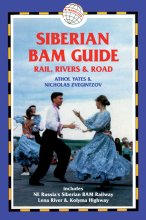I've said it before and I'll say it again, Trailblazer guides take some beating.
— Adventure Travel

Siberian BAM Guide: rail, rivers & road
Excerpt:
Introduction
Contents list | Introduction | Planning your trip | Itineraries | Sample route guide

East of the great Siberian plain rise formidable mountain barriers stretching more than 3,000km to the Pacific and the Arctic oceans. This is the Russian north-east – famous for political exiles, pristine environment, indigenous villages, cold war secrets and communist dreams. The region contains the world's largest contiguous forest and fertile wilderness. At the same time it is the site of the largest single civil engineering project of the post-war world – the 3400km BAM railway and its visionary cities. It is Russia's last frontier.
In many ways, it is a region of secrets. First, it is dauntingly inaccessible. Jumbled mountain ridges with thickly wooded valleys and flanks scored with rock slides can only be travelled where rivers have dug their twisting canyons. Along the rivers, trappers, merchants and exiles travelled by boat in the summer and by sled in the winter. Settlers built trading posts and then towns and then cities by the rivers. Yet beyond the rivers the mountains kept their secrets.
Second, the region was politically closed. Throughout the Soviet era all foreigners and most Russians were banned from the entire area. Behind the barrier were gulags, military installations and sophisticated defence industries. Many residents have never met a Westerner.
Third, the region is something of a vacation secret for adventure travellers from the rest of Russia. Parties travel to the north-east for days in the train with packs, tents, kayaks, and floats to run the wild and almost endless rivers, or in winter to ski across inaccessible passes and sauna in hot springs with ice in their hair. But tourists in the usual sense are few and far between. You can travel all over the railways, rivers and roads of the north-east and never see a Western traveller.
The traditional highways of the region are the great rivers – the Yenisei, the Lena and the Amur. The Russian settlements of the 17th century, now cities – Irkutsk, Yakutsk, and Khabarovsk – are built on these rivers. The great road across the continent, which was paralleled in 1897 by the Trans-Siberian railway, leapfrogged between the rivers to reach the Pacific at Vladivostok by the easiest path.
The Soviet state, with its boundless enthusiasm and abundant free labour, dreamed of opening up direct pathways through the north-east mountains, links between the cities, access to gold, diamonds, coal and timber. In 1933 the government published plans for a new railway, the BAM or Baikal-Amur Mainline, to branch off from the Trans-Siberian at Taishet in eastern Siberia, head north of Lake Baikal and cross the mountains to the Pacific harbour of Sovetskaya Gavan, 900km north of Vladivostok. In 1937, the AYaAD, the Amur Yakutsk Highway, was completed due south from Yakutsk to Bolshoi Never on the Trans-Siberian, crossing two major chains of mountains and many rivers. Construction of the BAM continued until Stalin's death in 1953, when most of the project was shelved.
In 1974 under Brezhnev the BAM was revived as a national priority and was made a Komsomol shock project, with the participation of the entire USSR. The golden spike completing the main line, was hammered in 1984 and the entire line was opened to all traffic by 1990. The route crosses three major mountain ranges and threads through the watersheds of all three major rivers. For most of the route, the railway is the only land access – roads are at best rugged, at worst non-existent.
Along the way, architects and construction brigades from all over the USSR created three new cities and over 100 new settlements. The BAM towns form a brilliant string of imaginative designs, boldly sited, vigorously built and filled with interesting buildings. The string of bold railway stations is a delight. It should be as famous in the wilds as the Moscow Metro is in the city!
This guide opens the Russian north-east to the visitor. It is not only a guide to travel but a handbook to this rarely visited region. It recognises that it is the culture, daily life and environment of people that is most interesting, rather than dry history and monuments. For this reason, the book emphasises the human aspects of the region, profiling a range of people, discussing the post-Soviet Russian culture and describing the daily life of the inhabitants and the towns.
Come and share the secrets of this fascinating region. Good journey!
Siberian BAM Guide: rail, rivers & road
Excerpts:
- Contents list
- Introduction
- Planning your trip
- Itineraries
- Sample route guide
Latest tweets